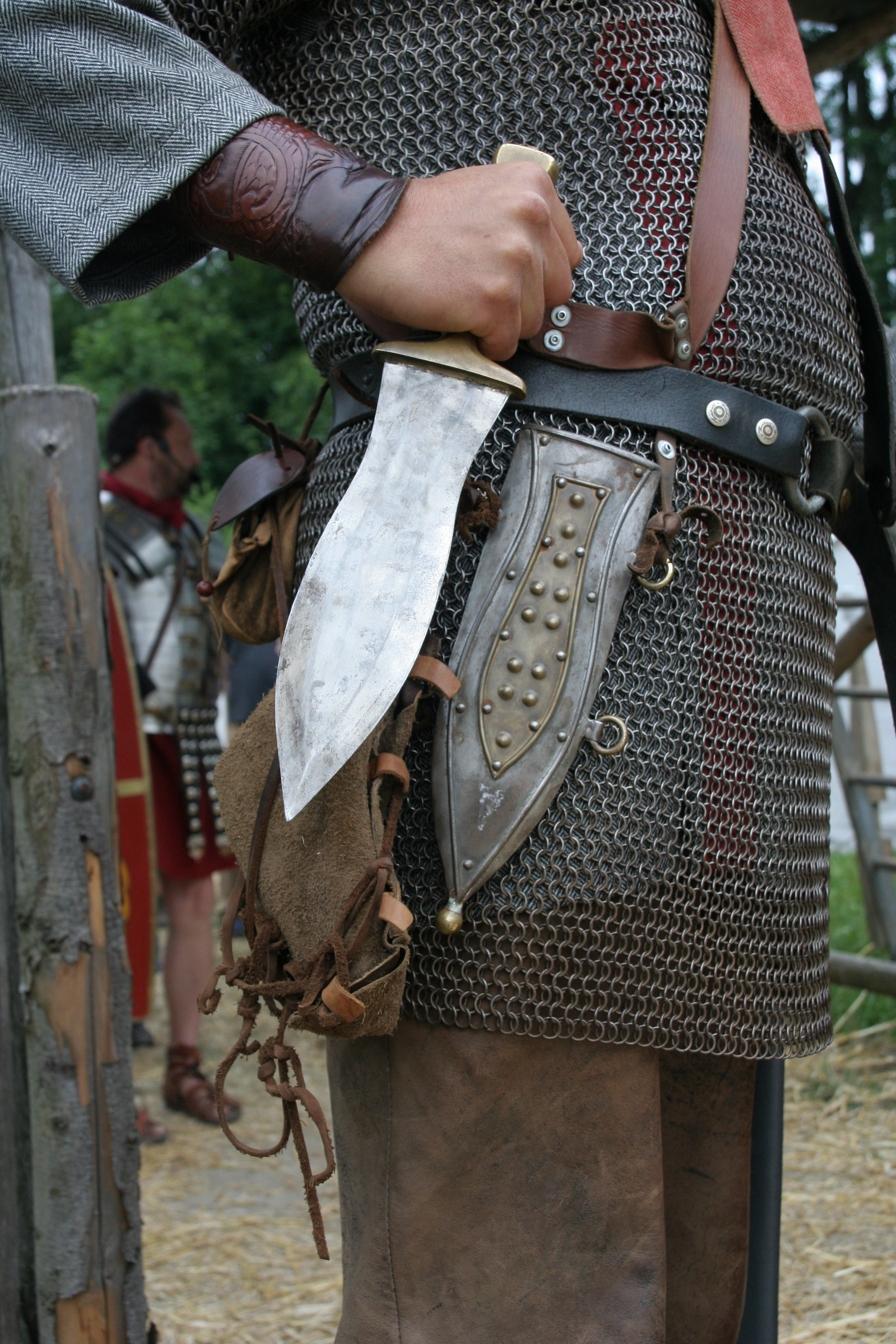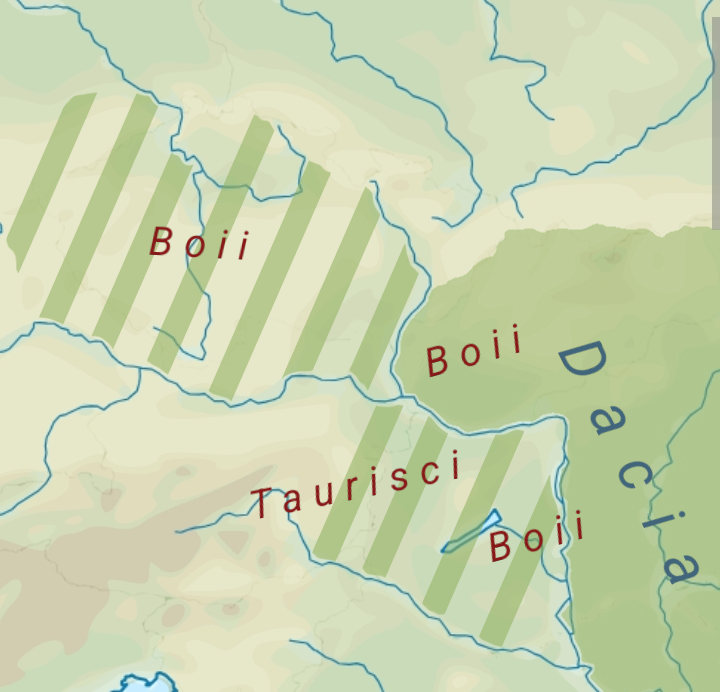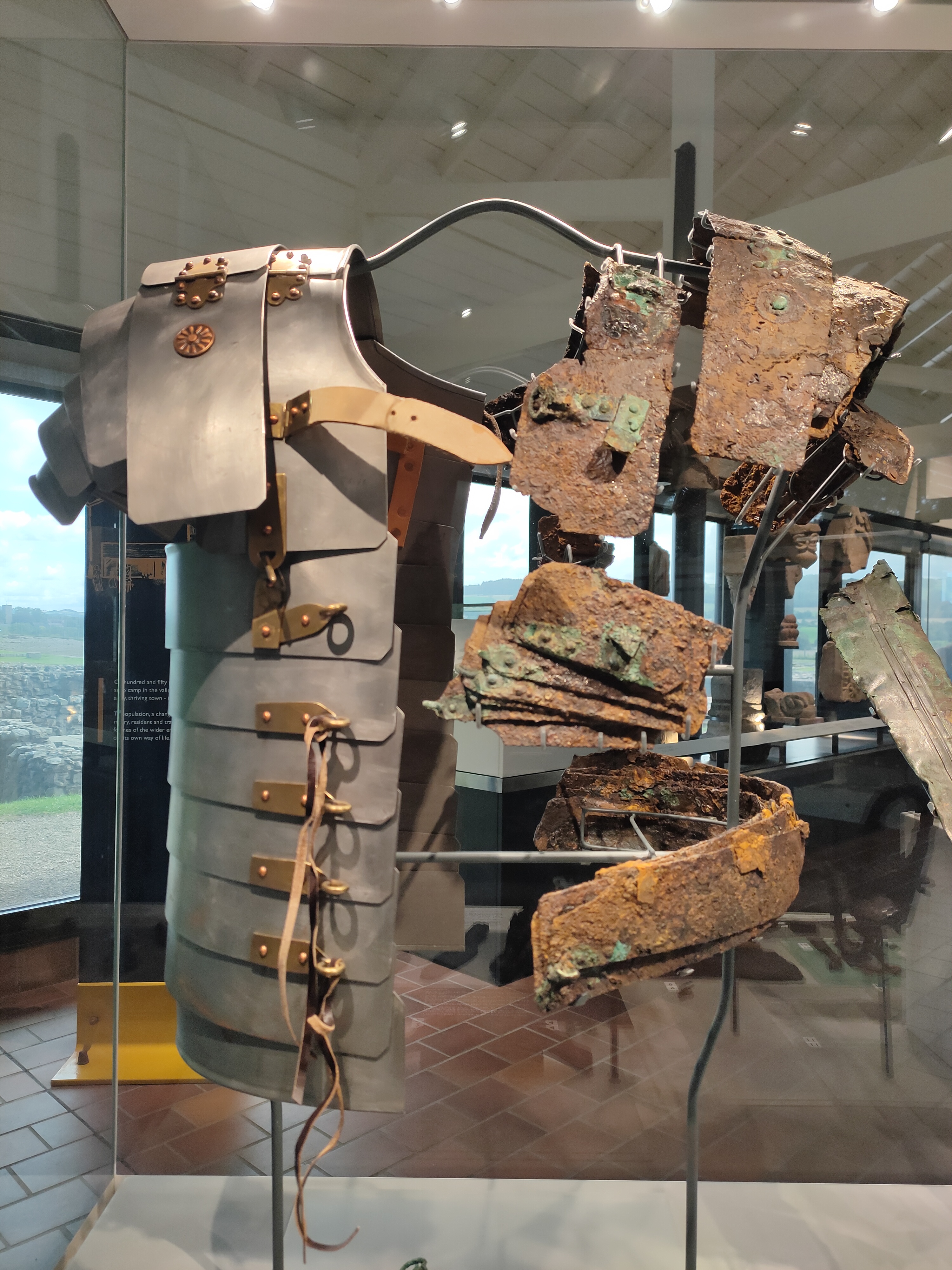|
Cingulum Militare
A ''cingulum militare'' was a piece of ancient Roman military equipment in the form of a belt decorated with metal fittings, which was worn as a badge of military status by soldiers and officials. Many examples were made in the Roman province of Pannonia.Crummy, Philip (1981). Colchester Archaeological Report 1/CBA Research Report 39: Aspects of Anglo-Saxon and Norman Colchester. Published by Colchester Archaeological Trust and the Council for British Archaeology. () The belt was composed of the following parts: # Balteus: Hanging band that was compounded for an overall band. # Bulla: Rivets on the baltea. # Pensilium: Pendant at the end of the straps of the belt. # Lamna: Discus at the end of each apron strip that embrace the pensilium. # Fibula: Buckle of the belt. The ''cingulum militare'' was used in conjunction with the helmet ('' galea''), the shield (''scutum''), the overall armor on the upper body (''lorica hamata''), a dagger (''pugio''), and a sword (''gladius''). See ... [...More Info...] [...Related Items...] OR: [Wikipedia] [Google] [Baidu] |
Roman Cingulum 1
Roman or Romans most often refers to: *Rome, the capital city of Italy *Ancient Rome, Roman civilization from 8th century BC to 5th century AD *Roman people, the people of Roman civilization *Epistle to the Romans, shortened to Romans, a letter written by Paul, found in the New Testament of the Christian Bible * Ar-Rum (), the 30th sura of the Quran. Roman or Romans may also refer to: Arts and entertainment Music *Romans (band), a Japanese pop group * ''Roman'' (album), by Sound Horizon, 2006 * ''Roman'' (EP), by Teen Top, 2011 *"Roman (My Dear Boy)", a 2004 single by Morning Musume Film and television *Film Roman, an American animation studio * ''Roman'' (film), a 2006 American suspense-horror film * ''Romans'' (2013 film), an Indian Malayalam comedy film * ''Romans'' (2017 film), a British drama film * ''The Romans'' (''Doctor Who''), a serial in British TV series People *Roman (given name), a given name, including a list of people and fictional characters *Roman (surname), ... [...More Info...] [...Related Items...] OR: [Wikipedia] [Google] [Baidu] |
Roman Military Personal Equipment
Roman military personal equipment was produced in large numbers to established patterns, and used in an established manner. These standard patterns and uses were called the ''res militaris'' or ''disciplina''. Its regular practice during the Roman Republic and Roman Empire led to military excellence and victory. The equipment gave the Romans a very distinct advantage over their "barbarian" enemies, especially so in the case of armour. This does not mean that every Roman soldier had better equipment than the richer men among his opponents. Roman equipment was not of a better quality than that used by the majority of Rome's adversaries. Other historians and writers have stated that the Roman army's need for large quantities of "mass produced" equipment after the so-called "Marian Reforms" and subsequent civil wars led to a decline in the quality of Roman equipment compared to the earlier Republican era: Initially, they used weapons based on Greek and Etruscan models. On encou ... [...More Info...] [...Related Items...] OR: [Wikipedia] [Google] [Baidu] |
Roman Province
The Roman provinces (, pl. ) were the administrative regions of Ancient Rome outside Roman Italy that were controlled by the Romans under the Roman Republic and later the Roman Empire. Each province was ruled by a Roman appointed as Roman governor, governor. For centuries, it was the largest administrative unit of the foreign possessions of ancient Rome. With the administrative reform initiated by Diocletian, it became a third level administrative subdivision of the Roman Empire, or rather a subdivision of the Roman diocese, imperial dioceses (in turn subdivisions of the Praetorian prefecture, imperial prefectures). History A province was the basic and, until the Tetrarchy (from AD 293), the largest territorial and administrative unit of the empire's territorial possessions outside Roman Italy. During the republic and early empire, provinces were generally governed by politicians of Roman senate, senatorial rank, usually former Roman consul, consuls or former praetors. ... [...More Info...] [...Related Items...] OR: [Wikipedia] [Google] [Baidu] |
Pannonia
Pannonia (, ) was a Roman province, province of the Roman Empire bounded on the north and east by the Danube, on the west by Noricum and upper Roman Italy, Italy, and on the southward by Dalmatia (Roman province), Dalmatia and upper Moesia. It included the modern regions western Hungary, western Slovakia, eastern Austria, northern Croatia, north-western Serbia, northern Slovenia, and northern Bosnia and Herzegovina. Background In the Early Iron Age, Transdanubia was inhabited by the Pannonians or Pannonii, a collection of Illyrians, Illyrian tribes. The Celts invaded in the Late Iron Age and Gallo-Roman culture, Gallo-Roman historian Pompeius Trogus writes that the Celts were met with heavy resistance from the locals and were not able to overrun the southern part of Transdanubia. Some tribes advanced as far as Delphi, with the Scordisci settling in Syrmia (279 BC) upon being forced to withdraw. The arrival of the Celts in Transdanubia disrupted the flow of amber from the Balti ... [...More Info...] [...Related Items...] OR: [Wikipedia] [Google] [Baidu] |
Galea (helmet)
A (; ) was a Roman soldier's metal helmet, most famously worn by the heavy infantry of the legions. Some gladiators, specifically ''murmillo'' ('' myrmillo''), also wore bronze ''galeae'' with face masks and decorations, often a fish on its crest. While details varied over time, all Roman galeas from the Republic era through the Principate featured the same basic design - a bowl to protect the skull, a neck guard (which grew larger over time), a deflector band to protect the forehead and cheek plates to protect the face. The exact form, type of metal, and design of the helmet varied over time, between differing unit types, and also between individual examples – pre-industrial production was by hand – so it is not certain to what degree there was any standardization even under the Roman Empire. Originally, Roman helmets were influenced by the neighboring Etruscans, people who utilised the "Nasua" type helmets. The Greeks in the south also influenced Roman design in its ... [...More Info...] [...Related Items...] OR: [Wikipedia] [Google] [Baidu] |
Scutum (shield)
The ''scutum'' (; :''scuta'') was a type of shield used among Italic peoples in antiquity, most notably by the army of ancient Rome starting about the fourth century BC. The Romans adopted it when they switched from the military formation of the hoplite phalanx of the Greeks to the formation with maniples (). In the former, the soldiers carried a round shield, which the Romans called a ''clipeus''. In the latter, they used the ''scutum'', which was larger. Originally, it was oblong and convex, but by the first century BC, it had developed into the rectangular, semi-cylindrical shield that is popularly associated with the ''scutum'' in modern times. This was not the only kind the Romans used; Roman shields were of varying types depending on the role of the soldier who carried it. Oval, circular and rectangular shapes were used throughout Roman history. History The first depictions of the scutum are by the Este culture in the 8th century BC, and subsequently spread to the Ita ... [...More Info...] [...Related Items...] OR: [Wikipedia] [Google] [Baidu] |
Lorica Hamata
The ''lorica hamata'' (in Latin with normal elision: ) is a type of mail armor used by soldiers for over 600 years (3rd century BC to 4th century AD) from the Roman Republic to the Roman Empire. ''Lorica hamata'' comes from the Latin ''hamatus'' (hooked) from ''hamus'' which means "hook", as the rings hook into one another. Usage Modern historians believe that mail armor was invented by the Celts. With the idea for this form of mail possibly coming to Rome during conflicts with the Celts in the 3rd century BC, lorica hamata was used by both legionary and ''auxilia'' troops. The first documented use occurred during the Roman conquest of Hispania The romans ruled and occupied territories in the Iberian Peninsula that were previously under the control of native Celtic, Iberian, Celtiberian and Aquitanian tribes and the Carthaginian Empire. The Carthaginian territories in the south a .... There were several versions of this type of armor, specialized for different military ... [...More Info...] [...Related Items...] OR: [Wikipedia] [Google] [Baidu] |
Pugio
The ''pugio'' (; plural: ''pugiones'') was a dagger used by Roman soldiers as a sidearm. It seems likely that the ''pugio'' was intended as an auxiliary weapon, but its exact purpose for the soldier remains unknown though it seems it could have been used for close quarters fighting. Officials of the empire took to wearing ornate daggers in the performance of their offices, and some would wear concealed daggers for defense in contingencies. The dagger was a common weapon of assassination and suicide; for example, the conspirators who stabbed Julius Caesar used ''pugiones''. The ''pugio'' developed from the daggers used by the Cantabrians of the Iberian peninsula. Etymology The word '' pūgiō'' derives from the word ''pungo.'' The root of the word is ''pug.'' The word derives from the Proto-Indo-European root ''*peuĝ''. It is still possible to use punch and stab synonymously in many Indo-European languages (even English, namely the "jab" in boxing); hence, Latin ''pugnus'' a ... [...More Info...] [...Related Items...] OR: [Wikipedia] [Google] [Baidu] |
Gladius
''Gladius'' () is a Latin word properly referring to the type of sword that was used by Ancient Rome, ancient Roman foot soldiers starting from the 3rd century BC and until the 3rd century AD. Linguistically, within Latin, the word also came to mean "sword", regardless of the type used. Early ancient Roman swords were similar to those of the Greeks, called ''xiphos, xiphe'' (, : ''xiphos''). From the 3rd century BC, however, the Roman Republic, Romans adopted a weapon based on the sword of the Celtiberians of Hispania in service to Carthage during the Punic Wars, known in Latin as the ''gladius hispaniensis'', meaning "Hispania, Hispanic-type sword". The Romans improved the weapon and modified it depending on how their battle units waged war, and created over time new types of "''gladii''" such as the ''Mainz gladius'' and the ''Pompeii gladius''. Finally, in the third century AD the heavy Roman infantry replaced the ''gladius'' with the ''spatha'' (already common among Roman ... [...More Info...] [...Related Items...] OR: [Wikipedia] [Google] [Baidu] |
Lorica Segmentata
The ''lorica segmentata'' (), also called ''lorica lamminata'', or ''banded armour'' is a type of personal armour that was used by soldiers of the Roman army, consisting of metal strips fashioned into circular bands, fastened to internal leather straps. The ''lorica segmentata'' has come to be viewed as symbolic of the Roman legions in popular culture. Name file:007 Conrad Cichorius, Die Reliefs der Traianssäule, Tafel VII (Ausschnitt 01).jpg, Roman legionaries marching across a pontoon bridge, a Roman sculpture, relief scene from Trajan's Column, the column of Emperor Trajan (r. 98-117 AD) in Rome, Italy (monochrome photography, monochrome photographs by Conrad Cichorius) In Latin, the name ''lorica segmentata'' translates to "segmented cuirass." However, this name was not given to the armor by the Romans. Instead, it was given by scholars in the 16th century. Despite the lack of knowledge on the Roman name for the armor, scholars can make educated guesses on the Roman n ... [...More Info...] [...Related Items...] OR: [Wikipedia] [Google] [Baidu] |
Ancient Roman Military Equipment
Ancient history is a time period from the beginning of writing and recorded human history through late antiquity. The span of recorded history is roughly 5,000 years, beginning with the development of Sumerian cuneiform script. Ancient history covers all continents inhabited by humans in the period 3000 BCAD 500, ending with the expansion of Islam in late antiquity. The three-age system periodises ancient history into the Stone Age, the Bronze Age, and the Iron Age, with recorded history generally considered to begin with the Bronze Age. The start and end of the three ages vary between world regions. In many regions the Bronze Age is generally considered to begin a few centuries prior to 3000 BC, while the end of the Iron Age varies from the early first millennium BC in some regions to the late first millennium AD in others. During the time period of ancient history, the world population was exponentially increasing due to the Neolithic Revolution, which was in full prog ... [...More Info...] [...Related Items...] OR: [Wikipedia] [Google] [Baidu] |






